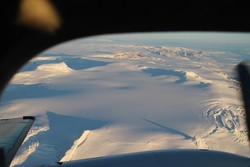Monitoring Öræfajökull
Scientists from IMO, the Earth Sciences Institute of the University of Iceland and a representative of the Icelandic Civil Protection Authority flew over Öræfajökull Saturday 18 November to assess ice-surface changes in the volcano's caldera. They have been meeting over the weekend to analyse recent measurements and assess the situation.
The overflights were made with helicopter support from the Icelandic Coastguard and an aircraft from Isavia. Additionally, water samples, measurements of electrical conductivity and gas levels were made on the ground at Kvíárjökull, a valley glacier on the southeastern flank of Öræfajökull. Apart from a stench of gas from the Kvíá river, there was no obvious sign of recent flooding. The ice cauldron that was reported on 17 November 2017 measures about 1 km in diameter and it is 15-20 m deep. While meltwater continues to drain from Kvíá, a large outburst flood seems unlikely.
Although there has been significant geothermal activity in the Öræfajökull caldera, there are no signs of an imminent volcanic eruption. There is considerable uncertainty about how the situation will evolve. The Icelandic Meteorological Office continues to monitor the region around-the-clock via seismic observations.
The ‘uncertainty phase' declared by the Icelandic Civil Protection Authority remains in force and IMO's aviation colour-code is unchanged at ‘yellow' for Öræfajökull.




